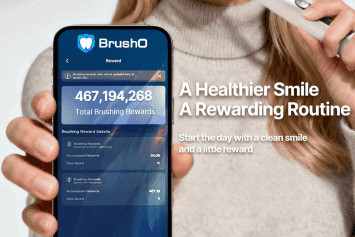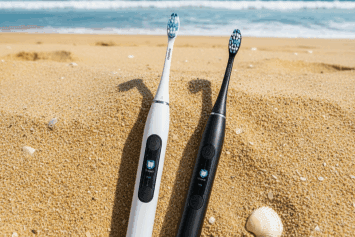Popular
How to Build the Perfect Oral Care Routine in 2025
Jul 30
Why Your Gums Bleed and How to Fix It Fast in 2025
Jul 30
Top 5 Oral Care Mistakes and How BrushO Fixes Them
Jul 29
What Makes a Toothbrush “Smart”?
Jul 22
BrushO Smart Toothbrush: Gentle, Powerful, Travel-Friendly
Jul 19
BrushO: The Future of Smart Oral Care—Redefining the Way You Brush
Jul 17
Back
Are Electric Toothbrushes good for Braces?Sep 25
Sep 25
Are electric toothbrushes better for orthodontic patients? Braces create unique oral care challenges—food and plaque build up around brackets, gums get irritated, and cleaning takes more time. Many patients and parents wonder: Should I switch to an electric toothbrush? Research shows that electric toothbrushes remove more plaque and reduce gum inflammation compared to manual brushing. In this article, we’ll explore the science, common mistakes orthodontic patients make, and how the BrushO Smart Toothbrush supports braces wearers with gentle bristles, smart pressure sensors, and real-time brushing feedback.

The Challenges of Brushing With Braces
Wearing braces makes oral hygiene much harder:
Plaque Traps → Brackets and wires collect food particles.
Sensitive Gums → Tightening braces often leaves gums sore.
Hard-to-Reach Areas → Manual brushes often miss spots behind wires.
Time Burden → Bracing patients often spend double the time brushing.
Without proper cleaning, patients risk cavities, gum disease, and even white spot lesions (early signs of enamel decay).
Electric vs. Manual Toothbrushes for Braces
Studies confirm:
Manual toothbrushes depend entirely on user technique, which is hard to perfect around brackets.
Electric toothbrushes deliver consistent, rapid movements that break up plaque more effectively.
One orthodontic study found that patients using electric toothbrushes had 22% less plaque and 18% lower gingivitis scores compared to manual users after 12 weeks.
👉 The conclusion: electric toothbrushes don’t just save time—they actually help braces patients maintain healthier teeth and gums.
Common Mistakes Orthodontic Patients Make
Even with an electric toothbrush, orthodontic patients sometimes make errors:
Brushing too hard → This can irritate gums already stressed by braces.
Using the wrong brush head → Hard bristles may scratch enamel and brackets.
Stopping too soon → Less than 2 minutes means plaque remains around wires.
Skipping the gumline → Most plaque hides where gums meet teeth.
User Stories: Life With Braces
Sophie, 15, wearing braces for 8 months:
“At first, brushing was a nightmare. Food got stuck everywhere, and I kept rushing. After switching to BrushO, the app showed me the spots I missed. My orthodontist even noticed my gums looked healthier at the next appointment.”
Daniel, 28, adult braces patient:
“I was worried about gum soreness. BrushO’s gentle mode and pressure alerts made a big difference—I no longer press too hard, and brushing feels safer.”
How BrushO Supports Orthodontic Patients
The BrushO AI-Powered Electric Toothbrush is tailored for braces wearers:
Smart Pressure Sensor → Prevents over-brushing that can harm gums around brackets.
Sensitive & Gum Care Modes → Gentle vibration options for orthodontic discomfort.
Real-Time Brushing Feedback → Ensures no spots are missed behind wires or at the gumline.
DuPont Soft Bristles → Gentle on brackets yet tough on plaque.
45-Day Battery + Qi Wireless Charging → Convenient for busy students and travelers.
What Dentists Recommend
Most orthodontists agree:
Electric toothbrushes improve plaque control for braces wearers.
Pressure sensors protect against gum irritation.
Brace patients should brush 3 times daily, especially after meals.
FAQ
Q1: Can electric toothbrushes damage braces?
No, when used with soft bristles and pressure control, they are safe.
Q2: How often should orthodontic patients replace brush heads?
Every 3 months, or sooner if bristles fray.
Q3: Is a smart toothbrush better than a basic electric one?
Yes. Features like BrushO’s AI tracking and real-time feedback ensure braces patients are cleaned thoroughly.
So, are electric toothbrushes better for orthodontic patients? Absolutely. They clean more effectively, protect sensitive gums, and make braces care easier. But not all brushes are equal. The BrushO Smart Toothbrush combines gentle bristles, smart pressure sensors, and AI-powered tracking to give orthodontic patients a healthier, more confident smile.
Popular
How to Build the Perfect Oral Care Routine in 2025
Jul 30
Why Your Gums Bleed and How to Fix It Fast in 2025
Jul 30
Top 5 Oral Care Mistakes and How BrushO Fixes Them
Jul 29
What Makes a Toothbrush “Smart”?
Jul 22
BrushO Smart Toothbrush: Gentle, Powerful, Travel-Friendly
Jul 19
BrushO: The Future of Smart Oral Care—Redefining the Way You Brush
Jul 17
Recent Posts

How High Sugar Intake Harms Your Oral Health
Excessive sugar isn’t just bad for your waistline—it wreaks havoc on your teeth. Discover how sugar impacts oral health and how smart brushing with BrushO can protect your smile.

How Sparkling Water Affects Your Enamel
Is sparkling water safe for your teeth? Discover how carbonation affects enamel, what science says, and how to drink smarter without harming your smile.

Does Lemon Water Help or Harm Your Oral Health?
Lemon water is praised for its detox benefits, but how does it affect your teeth? Learn the truth about acidity, enamel erosion, and how to protect your oral health with every sip.

Is Brushing with Salt Effective?
Can salt really clean your teeth or whiten your smile? Discover the science behind brushing with salt and whether it’s safe for your oral health.

Oral Health for Women During Pregnancy
Pregnancy affects more than your body—it changes your oral health too. Discover how hormonal shifts influence gum health, tooth sensitivity, and the importance of prenatal dental care.

Why Some People Struggle to Keep Brushing Habits
Many people struggle to maintain consistent brushing habits. Discover the psychological, behavioral, and lifestyle reasons behind poor brushing routines—and how smarter guidance can help build lasting oral care habits.

The Hidden Risks of Frequent Sipping
Think sipping beverages all day is harmless? Discover how frequent sipping—yes, even of healthy drinks—can silently damage your teeth, and how to protect your enamel with smarter habits and advanced solutions like BrushO.

The Best Christmas Gift I’ve Ever Received
Discover why an AI-powered toothbrush became the best Christmas gift I’ve ever received. Learn how smart brushing changed my routine, health, and confidence — all in just two minutes a day.

How Kids Can Compete for Brushing Rewards with BrushO
Turn brushing into a fun daily challenge! Discover how BrushO transforms kids’ oral care habits through competitive rewards, smart scoring, and daily motivation.

How BrushO Uses AI to Track Missed Spots
Struggling with missed areas during brushing? Discover how BrushO’s AI technology ensures full-mouth coverage by detecting and tracking the spots you often overlook.
